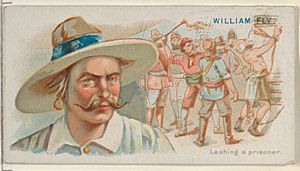William Fly facts for kids
Quick facts for kids
William Fly
|
|
|---|---|
 |
|
| Died | 12 July 1726 |
| Cause of death | Execution by hanging |
| Known for | Considered one of the last pirates of the Golden Age of Piracy |
| Criminal charge(s) | Piracy |
| Criminal penalty | Execution by hanging |
| Criminal status | Executed |
| Piratical career | |
| Allegiance | none |
| Years active | 1726 |
| Rank | Captain |
| Commands | Elizabeth |
William Fly was an English pirate who sailed the seas in 1726. For about three months, he attacked ships near New England. He was eventually caught by the crew of a ship he had taken over. William Fly was later executed in Boston, Massachusetts. His body was then displayed as a warning to other pirates. Many people see his death as the end of the exciting time known as the Golden Age of Piracy.
Becoming a Pirate Captain
William Fly's journey as a pirate started in April 1726. He joined a ship called the Elizabeth. The ship was sailing to West Africa with Captain John Green. Fly and Captain Green did not get along well.
One night, William Fly and other sailors took control of the ship. They had a disagreement with Captain Green. After taking over, the sailors made a Jolly Roger flag. This is the famous pirate flag with a skull and crossbones. They renamed their ship Fames' Revenge. The crew then chose William Fly to be their new captain.
Adventures at Sea
Captain Fly and his crew sailed to the coast of North Carolina. From there, they headed north towards New England. In just about two months, they managed to capture five different ships.
However, their time as pirates did not last long. William Fly and his crew were soon captured themselves.
William Fly's Final Message
William Fly and his crew were executed in Boston Harbor on 12 July 1726. Before his death, Fly shared an important message. He wanted to warn ship captains to treat their sailors fairly. He also urged them to pay their sailors on time.
He said that poor sailors often did not get justice. He felt that captains could abuse sailors without consequence. Fly hoped that all ship captains would learn from what happened to him. He wanted them to always pay sailors their wages when they were due.
After William Fly was executed, his body was hung in chains. This happened on Nixes Mate Island in Boston Harbor. It was meant to be a strong warning to anyone thinking of becoming a pirate.

